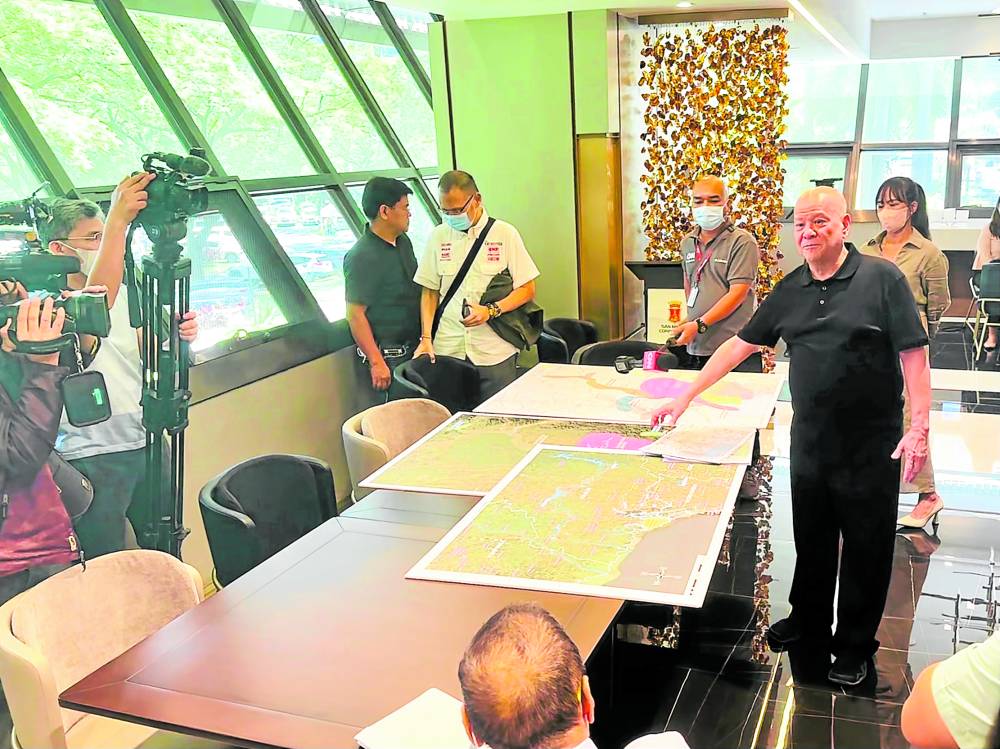San Miguel, the P1.5-T conglomerate, moves to solve Bulacan, Pampanga flooding

The 10th of August, a Thursday, was a busy workday for billionaire Ramon Ang.
Hours before other employees began arriving for work, the president and CEO of San Miguel Corp. (SMC) had begun to receive guests at the Mandaluyong City headquarters of the conglomerate that produces everything from beer, household food items, refines and retails petroleum, generates electricity and runs the most extensive network of toll highways in the country.
At 7 a.m., the helicopter of a provincial governor landed on the company’s roofdeck helipad, while vehicles of other town mayors and national and local government officials arrived soon after. They were followed by media vehicles carrying reporters with their television camera crew in tow.
The agenda was the severe flooding experienced by residents in the provinces of Pampanga and Bulacan three weeks prior. One specific concern was the inundation of a short segment of the North Luzon Expressway, owned by rival firm Metro Pacific Tollways Corp., which had inconvenienced thousands of motorists traveling north of Manila.
And in recent days, San Miguel—whose big-ticket infrastructure projects have become a favorite target of environmentalists, some well-intentioned and some encouraged by corporate rivals—was being blamed for the flooding by local officials who were pointing at the firm’s massive airport project along Bulacan’s Manila Bay shoreline.
“They say this is being caused by our reclamation project. That’s not true. They keep talking without understanding the real problem first,” Ang tells his assembled guests as they pore over large maps spread out over a long conference table. Of particular interest to them is a 1990s map of the province made by the National Mapping and Resource Information Agency (Namria) that shows the airport project site as a solid land mass, surrounded by water channels on either side. Another map from the Department of the Environment and Natural Resources shows the same details.
“First of all, we’re not reclaiming any new land. These are titled lands we’re building on,” he adds, explaining that previous owners of the 2,500 hectares where the New Manila International Airport is being built allowed the area to be inundated so that they could be used as commercial fishponds. “We’re just restoring them to their previous status.”
The real problem

Pointing at the Namria map, Ang explains that there is no way the land redevelopment work for the airport is blocking the outflow of rain water from Pampanga and Bulacan into Manila Bay. He notes that the airport project site being worked on by Dutch firm Boskalis (the biggest and best dredging firm in the world, he points out) is now like an island where excess water can flow around unrestricted.
“The real problem is the siltation of the rivers in Pampanga and Bulacan, which has reduced their carrying capacity [for water],” he says. “Because silt deposits have made these waterways so shallow in recent years, it only takes a little rain for these rivers to overflow and flood the surrounding areas.”
And in typical Ramon Ang fashion, the tycoon surprises his assembled guests by announcing that San Miguel will take it upon itself to dredge the rivers and clear the waterways of both provinces, even some that extend hundreds of kilometers away from the airport development—and even if, strictly speaking, doing so is the responsibility of the government.
‘Small price to pay’
It is an expensive undertaking, but Ang says it is a good use of the conglomerate’s resources, pointing to the fact that the recent rains brought little or no flooding to Metro Manila areas that would normally be inundated after even moderate rainfall.
San Miguel has spent P3 billion over the last three years dredging and cleaning up the Pasig, Tullahan and San Juan Rivers, removing almost two million tons of solid waste and silt in the process. Ang says this effort will now be duplicated in Pampanga and Bulacan to ensure that the flooding experienced last month will not be repeated.
Costly as this new undertaking will be, a cursory look at San Miguel’s financial statements and performance in recent years shows that it has resources to spare.
In terms of revenues, San Miguel is the country’s largest conglomerate with the total sales of all its operating units hitting P1.5 trillion last year, after “slumping” to P725 billion when the pandemic hit in 2020. For 2024, it is again expected to hit P1.5 trillion in revenues, at least.
At the nominal value of the country’s latest gross domestic product, the conglomerate is responsible for almost 7 percent of Philippine economic output in any given year. It is also the country’s largest taxpayer.
And at a projected cost of P740 billion, the San Miguel’s four-runway airport project in Bulacan is also the single biggest infrastructure investment made in the country’s history whether by the government or the private sector.
Apart from the airport project, the conglomerate is also constructing a commuter rail system — the Mass Rail Transit, Line 7 — that will connect Quezon City to Bulacan and give people a faster, more convenient commute starting next year.
San Miguel will also build an elevated toll highway along the Manila Bay shoreline that will extend Roxas Boulevard in the capital all the way to its Bulacan airport just a few kilometers north so that travelers can cover the distance that would normally take hours in just a few minutes.
So, apart from making good business sense, another P3 billion to mitigate flooding is a small price to pay if it means better lives for people in the surrounding communities, Ang says, as his guests exchange nodding glances.
“Even if it’s not our direct responsibility, we will do it. We will spend for it,” Ang says. “It’s for our country.”

